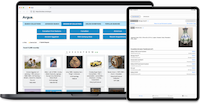Museum TrendsWatch 2024: Digital Twins and Doom Loops & Combatting the Loneliness Crisis

Rachael Cristine Woody
The Center for the Future of Museums (under the American Alliance of Museums) publishes a TrendsWatch report annually. Today’s post will focus on the smaller trend areas: Digital Twins and Doom Loops, and Combatting the Loneliness Crisis.
With a combination of strategic foresight, global visioning, and keeping up with the latest in ethics and technology, the Center delivers content on wide ranging topics housed within a theme. This year the report theme is TrendsWatch: Navigating a Volatile Future and includes three main trends: Culture Wars 2.0, AI Adolescence in Museums, and Decarbonizing the Future. Then, in the pattern they adopted last year, a Short Take: Dropping the Degree; a For Your Radar: Digital Twins and Doom Loops; and a Trend Alert: Combatting the Loneliness Crisis.
The intention of this miniseries is to offer TrendsWatch snapshots to support distillation and application at museums. For our purposes we’ll cover each trend with a post. Today’s post will wrap up the TrendsWatch series with a focus on the smaller trend areas: Digital Twins and Doom Loops, and Combatting the Loneliness Crisis.
For Your Radar: Digital Twins and Doom Loops
The For Your Radar section allows TrendsWatch to alert readers to the latest terms that may impact the museum world, but without the additional detail and advice that’s usually included with their trends coverage.
Digital Twins is the construction of a digital surrogate for a person, place, or thing. Once constructed, the digital twin—and the technological apparatus running it—can use real or fake data to play out a number of scenarios. Elizabeth Merritt, Founding Director of the Center for the Future of Museums provides several examples from oil rigs, to the city of Shanghai, to electromagnetics in humans to treat Alzheimer’s disease. Even the Natural History Museum in London uses a digital twin to help better manage their physical collections.
Doom Loops are self-perpetuating phenomenon of negative action instigating negative consequences, instigating negative action. The example Merritt provides is an urban doom loop that began during the pandemic days of empty offices in city centers. This resulted in lower foot traffic, to small business closures, to city centers losing a significant amount of revenue. The human cost being job loss, experiencing homelessness, limited access to city services, and experiencing an increase in crime. Together they all contribute to the loop because together they make the city less appealing to live in or establish businesses.
Trend Alert: Combatting the Loneliness Crisis
The Trend Alert section highlights a trend already in play and usually with a direct connection to a museum’s purpose. The loneliness crisis is one museums can directly influence for the positive and Merritt provides some suggestions for how to do so. But first, what is the loneliness crisis? It’s not surprising that the isolating effect of the pandemic left the majority of us feeling disconnected. The statistics Merritt shares with us are that loneliness affects:
- ~1/3 of US adults 45 and older
- ~80% of young adults (18-24)
The probability of loneliness impacting someone increases if they are members of one or more non-dominant cultural communities e.g. Black or Indigenous people and/or LGBTQIA.
The TrendsWatch report goes on to explain how—in addition to obvious contributors such as social media—the decline in community spaces is contributing to loneliness—which is a callback to Culture Wars 2.0 where Merritt’s encourages museums to become a “third place” for community members to connect. The section ends with advice on what museums can do:
- Become a “third place” with programs to help encourage community connections.
- Embed social connection as a strategic priority into policies, practices, programs, etc.
- Build partnerships with other community centers.
- Create awareness of the problem through public programming.
- Create education, resources, and support—especially for those populations most at risk for loneliness.
- Model healthy examples and become a leader in fostering community connections.
Conclusion
This year’s TrendsWatch theme is Navigating a Volatile Future, one in which Merritt uses the strategic foresight definition to mean the speed of change. The museum field is not used to being fast paced or easily changed. What is perhaps the most interesting about these trends is that they’re newer concepts and yet they’re concepts that will likely be with us and increasing in presence for the rest of our lives. I look forward to seeing how we rise to the occasion and where these future trends will take us.

Rachael Cristine Woody
Rachael Woody advises on museum strategies, digital museums, collections management, and grant writing for a wide variety of clients. She has authored several titles published by Lucidea Press, including her newest: Demystifying Data Preparation for a New CMS. Rachael is a regular contributor to the Think Clearly blog and always a popular presenter.
**Disclaimer: Any in-line promotional text does not imply Lucidea product endorsement by the author of this post.
Never miss another post. Subscribe today!
Similar Posts
No-Code Digital Storytelling Example: Rembrandt’s Self-Portrait at Kenwood House
Explore how English Heritage’s Kenwood House uses the no-code platform Shorthand to bring Rembrandt’s Self-Portrait with Two Circles to life through visual storytelling and interactive design.
Exploring No-Code Digital Storytelling: Hoover’s “Fanning the Flames” Exhibit
Explore no-code digital storytelling with Hoover’s ‘Fanning the Flames’ exhibit. See how interactive tools (Deep Zoom Color Compare & Hot Spot) enhance user engagement and the visual experience.
An Introduction to Scrollytelling for Museums
Discover how museums use scrollytelling and digital storytelling platforms to create immersive narratives. This introduction explores key concepts and approaches to interactive storytelling.
Exploring Self-Determinate Multiple Pathways: An Example of Digital Storytelling
Discover how self-determinate multiple pathways offer flexible interactive storytelling in museum exhibits. Learn from the Tenement Museum’s ‘Your Story Our Story.’







Leave a Comment
Comments are reviewed and must adhere to our comments policy.
0 Comments